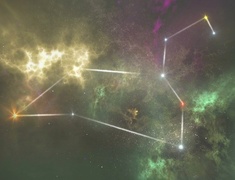
The 88 Modern Constellations - Part 4 (Leo - Perseus)
Last updated: Tuesday January 5th, 2021
Report this blog
46. Leo (in the thumbnail)
Area: (12th)
Symbolism: The lion. The Ancient Greeks connected it with the Nemean Lion killed by Heracles/Hercules as one of his twelve labors. It is one of the 12 zodiac constellations. The lion's mane and shoulders also form an asterism known as "The Sickle"
47. Leo Minor
Area: (64th)
Symbolism: The smaller lion. It has no mythological story behind it. Just the small counterpart of Leo listed by Hevelius.
48. Lepus
Area: (51st)
Symbolism: The hare chased by Orion or by Orion's hunting dogs (Canis Major). This makes sense since Canis Major and Orion border the constellation
49. Libra
Area: (29th)
Symbolism: The scales. In Ancient Greece it was seen as Scorpius's claws. Just like Lepus, this makes sense since Scorpius borders Libra.
Fun Fact: 4 tropical cyclones have been named after this constellations and zodiac sign, specifically the cyclones are called Tembin. In Japanese it translates to, what else? Libra.
50. Lupus
Area: (46th)
Symbolism: The wolf
51. Lynx
Area: (28th)
Symbolism: The lynx. It played a prominent role in Greek mythology. It is considered an elusive and mysterious creature.
52. Lyra
Area: (52nd)
Symbolism: The lyre. Lyra's brightest star, Vega, forms a corner of the famed Summer Triangle.
53. Mensa
Area: (75th)
Symbolism: The table, sometimes it's called Table Mountain, because Hevelius named it in honor of the Table Mountain in South Africa. This constellation appears in the Southern Hemisphere, Table Mountain is also located here!!!
54. Microscopium
Area: (66th)
Symbolism: The microscope
55. Monoceros
Area: (35th)
Symbolism: The unicorn. The meaning comes from the Ancient Greek μονόκερως, which is made up by the words μόνος which means only or single and κέρας which means horn.
56. Musca
Area: (77th)
Symbolism: The fly
57. Norma
Area: (74th)
Symbolism: The carpenter's square or a ruler. The Milky Way passes through this constellation
58. Octans
Area: (50th)
Symbolism: The octant
59. Ophiuchus
Area: (11th)
Symbolism: The serpent-bearer, specifically the god of medicine, Asclepius. The rod with the snake on it was a symbol of him. The name is a Latinized version of Οφιούχος. It's commonly depicted as a man grasping the snake, Serpens. The constellation Serpens is unique, and you will learn that in the next part. Ophiuchus has been theorized as the 13th sign of the zodiac, it even has it's own symbol.
60. Orion
Area: (26th)
Symbolism: Perhaps the most recognizable constellation globally. Orion, is a hunter from Greek mythology. He is depicted standing next to Eridanus with his two hunting dogs Canis Major, fighting Taurus or as we said earlier, hunting Lepus with his two dogs. One myth recounts Gaia's rage to Orion, who said that he would kill every animal on Earth. The goddess tried to dispatch him with a scorpion. However, Ophiuchus revived Orion with an antidote. The constellation is known for the stars Rigel and Betelgeuse, and its "Belt" with the stars Alnilak, Alnitam and Mintaka.
61. Pavo
Area: (44th)
Symbolism: The peacock. The peacock was a symbol of Hera in Greek mythology.
62. Pegasus
Area: (7th)
Symbolism: Pegasus, a winged horse with magical powers from Greek mythology, who was born after Perseus slew Medusa.
63. Perseus
Area: (24th)
Symbolism: Perseus, a hero from Greek mythology. He was son of Danae, who was sent to bring the head of Medusa, the Gorgon. Perseus slew Medusa in her sleep, and Pegasus and Chrysaor appeared from her body. Perseus also rescued his wife Andromeda, from the sea-monster Cetus. Perseus borders and lies near the constellations Andromeda, Cepheus, Cassiopeia (Andromeda's mother), Cetus and Pegasus. Sometimes constellations can narrate full stories and myths...
